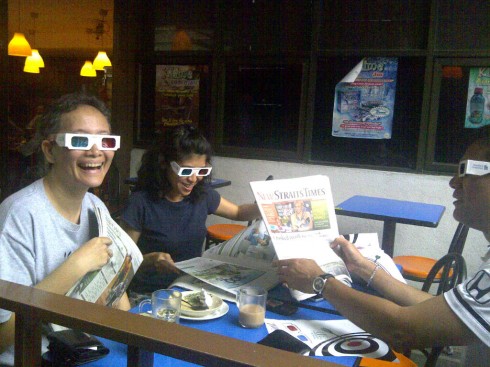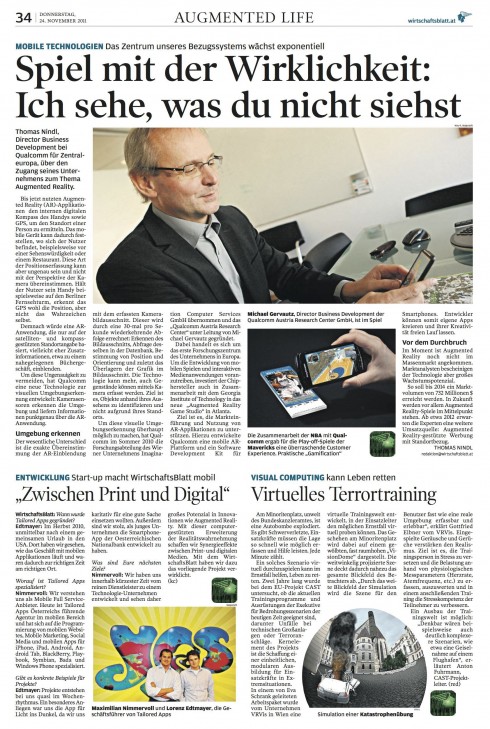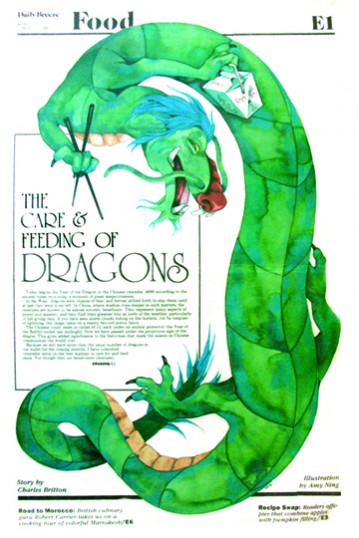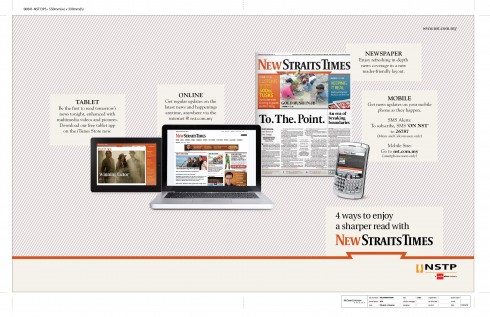TAKEAWAY: Newspapers that talk, pages coded to turn images into moving objects, and now Google-made glasses that will be able to stream information to the wearer’s eyeballs in real time. More than brave, the new media world is full of possibilities. PLUS: Discussing nostalgia? Let’s not forget the dragon page, or the eggs page, please
This is the weekend edition of TheMarioBlog, to be updated as needed. Next new blog post is scheduled for Monday, February 27
The sounds of print
See video to follow the motions, and hear the sound.
What a surprise here in Malaysia to open a copy of the New Straits Times, a newspaper whose new look we at Garcia Media launched 11-11-11, and , suddenly, “sound” came out of the pages.
Has the talking newspaper arrived? Yes, apparently so: a newspaper that talks and laughs is here.
This week the newspaper featured a pre-recorded advertisement by the sponsor, Friso, a premium milk powder company, and audio of three selected articles that could be accessed by scanning the QR code.
Some of the young readers interviewed upon publication described the NST idea as “cool”.
For the experimental guys in the marketing department of the NST, everything is possible. Remember that we had to put 3D glasses on to read the first edition of the newly redesigned newspaper?

This is a scene from 11-11-11 when the NST published its first 3D edition
For the New Straits Times story go here:
http://www.nst.com.my/local/general/amazement-wonder-greet-talking-nst-1.50244
In Austria: WirtshaftsBlatt goes for augmented reality
Here is a video showing how the Augmented Reality supplement worked




Here are assorted pages from the Augmented Reality printed supplement, you can see where the code appears
Another exciting technology is augmented reality, samples of which we have seen sporadically used on magazine covers, such as Esquire.
Those digital guys at the WirtschaftsBlatt of Austria are already experimenting with this on the pages of their printed newspaper.
Here is how Klement Cabana, the WirtschaftsBlatt’s project manager for digital media, describes the term “augmented reality” within the scope of his project :
For us, the term „Augmented Life“ stands for the computer-supported expansion of the sensory perception of humans through the integration of surrounding characteristics and information that would otherwise remain outside of experience.
In a presentation Klement has sent me, he cites a fascinating statistic: In 2013, according to current estimates already in 2012, mobile Internet access will overtake stationary access!
This, he says, is what justifies the integration of “augmented reality” into the content strategy of WirtschaftsBlatt with two specific objectives:
“Making print more attractive. Revamping advertisement subjects by backing them with multimedia content generates crossmedia approaches.
Making information more attractive by enriching it with added value. Time factor and quality play a significant role.”
The WirtschaftsBlatt has already published its first “augmented reality” supplement, which readers truly appreciated as the novelty it is these days.
Was it easy to execute?, I asked.
Indeed, or at least not complicated, according to Klement’s report:
?
?
?
Augmented Life Technical Specification
—Linking print with multimedia content is done using „markerless“-technology. A „coded image“ retrieves downstream content from the Content Management System.
—Access is easy for the readers. A „player“ that is included in the existing WirtschaftsBlatt-applications (and is also available as „Stand-Alone-solution“ ), activates the mobile phone camera. When a certain image is captured by the camera, additional content is retrieved.
“We require the following additional documents in parallel to the transfer of the print-PDF (at the latest 3 work days prior to the publishing date) for the deadline for print materials:
The image that is used in the print subject or the entire subject as *.jpg Format as of 640×480 Pixels. Depending on size.
?The more contrasts the initial image has, the better the event triggering works
Some pages from the special “Augmented Reality” supplement appear here, so that you get a sense of where the codes appeared. I have experienced it, and was quite impressed by the way stories that appear as they usually do within a print reference, suddenly had added value—a video, an animated graphic.
Those wishing to have more information, contact Klement Cabana here:
klement.cabana@wirtschaftsblatt.at
….and visions in real time
Those 3D glasses and sounds may just be the icing on a cake that promises much more, as in great views of that information you crave via a pair of Google-made glasses that will be able to stream information to the wearer’s eyeballs in real time.
Mind boggling? Perhaps, and expensive, for sure, but according to 2009 PDF from design consultancy IDEO demonstrates some of the potential journalistic uses for augmented reality: On the print side, you could have the glasses add additional photos or video to newspaper stories.
The talking newspaper which surprises is all part of what appears to be the direction media innovation is moving towards.
Get to all the senses, quickly and in an entertaining way.
Nostalgia revisited: when avocados, dragons and eggs founded space

Page designed by Jeannie Grand during her tenure at The Daily Breeze, of Torrance, California, late 1980s
Our blog take on nostalgia and “dated” designs prompted many reactions and emails. Some of those writing to me longed for the days of the “avocado page”, design departments motivated to take risks, and with plenty of space to achieve it.
Among the dozens of emails, one stood out, complete with an attachment that you see here. It is Jeannie Grand’s “dragon page”, done for The Daily Breeze. I remember it well. I worked with Jeannie and her team at the Breeze——isn’t that the best newspaper name ever? I think that their marketing campaign went something like: Give us each day our daily Breeze.
Priceless, of course.
And I remember my time with the Breeze’s team as a wonderful, “breezy” one, if you will, but especially working with Jeannie, and with the late Charlie Britton (food editor), Lisa Reitzel (assistant managing editor) and people who were always ready to have a little fun with the work they did so responsibly and well. Laughter was an essential ingredient of that design department. The pages they produced show it!
Here is Jeannie’s note to me when she read the nostalgia blog:
“We did some fun pages. One of my favorites being the dragon page for Chinese New Year.The dragon page came about when I wanted to do something fun with Chinese New Year instead of using the art I had been given. The freelance illustrator I used was Amy Ning,”
“These are like the avocado pages, no one would let you do anything like that these days, but it was fun to be in the newspaper design
racket when it was possible to do wacky things and to have an editor
like Charlie with a great sense of humor who let people like me
spread their design wings.”
The most memorable page of all
The many mails I have received on my brush with nostalgia this week bring to mind the ultimate page of the era .
I remember it in picture perfect fashion, and how I wish we could see it again.
It was a page designed by my former student, the great Nanette Bisher for the Orange County Register, in the late 80s or early 90s.
The image: a full picture of just a woman’s leg riding on stiletto shoes with the thinnest of heels (yes, women wore those long before the glamorous girls from Sex and the City got on their Manolos!), and the tip of the heel almost ready to step on the yolk of a freshly fried egg.
The headline: Eggs—beat them, whip them, but respect them in the morning.
This page was as delicious as the plate of eggs it displayed. And quite controversial with critics who considered the headline “sexist”. But, oh, if there are memorable moments in the hall of fame of pages that transcend their 24-hour shelf life, this was it.
I have asked my dear friend Nanette to send me an image of that page if she still has it. Even today, I would give it three gold medals, rate it Best of Show, and, indeed, Best of the Avocado Pages. They don’t design them like that anymore.
As Jeannie Grand puts it: “Oh, for the good old days, Unfortunately we can probably put a — 30 — on those, too.”
(For the very young reading this, -30- was the editing symbol reporters and copy editors used to signify “the end”.)
The media quartet at the New Straits Times

Here is how the New Straits Times of Malaysia presents its four platforms to readers, via full page ads in the printed newspaper, among other media
I have spent this week in Malaysia, this time working with Berita Harian, sister Malay language newspaper to New Straits Times. I am happy to see that the New Straits Times continues to do well, and that its emphasis is on storytelling across platforms.